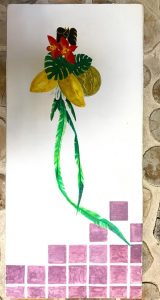Student Robert Propst invites readers into the world of Guatemala, where he and other members of the spring Guatemala and Colombia trip led by Professor Ann Hershberger and her husband, Jim. Other groups living and learning off campus this semester are at the Washington Community Scholars’ Center in Washington D.C., with Professor Kimberly Schmidt and in the Middle East with Professor Linford Stutzman and wife, Janet.
Follow the activities and learning of our cross-cultural programs this semester on the Cross-Cultural Blog and on Facebook.
The Symbolic Universe of Guatemala, by Robert Propst

Some of the most important things are invisible and impalpable. Love has no color. Freedom has no taste. Hope has no smell. Peace has no texture. Respect has no sound. For this reason, we have developed symbols. Hearts represent love, for example. But the symbols we use are by no means the objectively correct symbols, so they are therefore free to vary by culture. In the United States, our flag represents freedom, and the eagle carrying an olive branch represents peace.
When we visited the cemetery in our first week of study, our guide, Joel van Dike, explained that to truly engage with a culture, one must enter the “symbolic universe” of a place. To understand Guatemala, one must understand Guatemala’s symbols. In the United States, the number 1776 signifies independence. Here, that number is 1812.
The image attached to this post is of a painting I saw in the Cloud Forest Conservation Center. I will use this to provide an introduction to Guatemala’s symbolic Universe.
The entire image looks roughly like a quetzal in flight. Indeed, the feathers are those of a quetzal. The quetzal is the national bird and also the name of the currency. (Why don’t we do that? As in, gasoline costs 2.50 eagles per gallon; I have ten eagles in my wallet; minimum wage is 7.25 eagles.) The quetzal is mostly green, but it bears many colors. It has elegant tail feathers and is extremely rare. It cannot live in captivity. It follows, then, that the quetzal symbolizes freedom and beauty.
There is also another kind of quetzal in this image, specifically the 1 quetzal coin. It’s worth a little less than one seventh of an eagle, I mean US dollar. On one side is the signature on the peace treaty that officially ended the armed conflict. Some violence is ongoing, but the signature nevertheless signifies peace.
Speaking of currency, the large yellow objects are the cocoa nuts. These were used by the Mayans as currency. Moreover, they were used to calculate transactions in the base 20 system used by the Mayan people. Plus, they make chocolate. Close to 50% of the population is indigenous, and most of the rest still have a little Mayan blood. The cocoa nut symbolizes, at least in this painting, Mayan heritage.
The leaves are of Monstera Deliciosa, commonly known as “swiss cheese plant” or “rib of Adam.” It is a plant native to Central America and probably has some cultural value that I am unaware of.
The flower in the painting is an orchid. I don’t know which species this is but there are a lot of species here. Orchids are highly complex flowers and often are adapted to attract a specific type of pollinator. Here, I think it symbolizes beauty and diversity.
This brings us to the head, a silhouette of a rooster. It is the logo of Gallo brand beer. It is a company based in Guatemala and owned by the very wealthy Castillo family. On one hand, the logo is a popular icon. On the other hand, it is a mark of inequality.
Let’s make a full circle back to the cemetery. Poor people are put into a common wall-like structure above ground and are removed when the family can’t pay. Wealthy families bury their dead in grand mausoleums. One mausoleum was huge, the color of sandstone, and decorated with Egyptian symbols like the sphinx. It reminds one of a pyramid, the tombs of great pharaohs constructed by slaves. It is the Castillo family tomb. To me this says: “We are the ruling class and you are the peasants.” So the Gallo logo represents the challenges that Guatemala faces. It also says that very few families are the head of the nation.
These are the masks the invisible qualities wear in Guatemala. Thank you for dipping your toes into my host-culture’s symbolic universe.

I hope you all are having the best time!